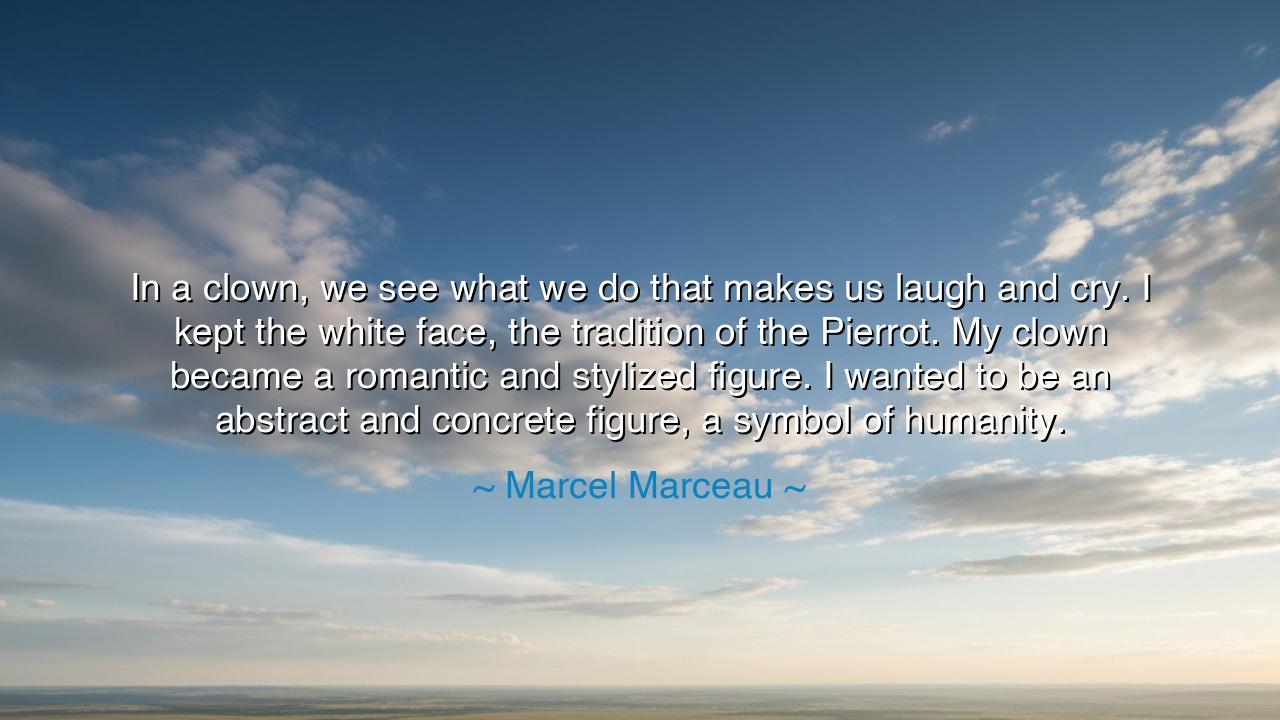
In a clown, we see what we do that makes us laugh and cry. I kept
In a clown, we see what we do that makes us laugh and cry. I kept the white face, the tradition of the Pierrot. My clown became a romantic and stylized figure. I wanted to be an abstract and concrete figure, a symbol of humanity.






Hear the words of Marcel Marceau, master of silence, who declared: “In a clown, we see what we do that makes us laugh and cry. I kept the white face, the tradition of the Pierrot. My clown became a romantic and stylized figure. I wanted to be an abstract and concrete figure, a symbol of humanity.” These words, born from a life lived in mime, are not about entertainment alone—they are a meditation on the very essence of what it means to be human.
The clown has always been more than a figure of jest. In ancient courts and traveling troupes, in circuses and street corners, the clown was a mirror, reflecting back to the people their own follies, sorrows, and joys. When he stumbles, we laugh at his clumsiness, yet in truth we laugh at ourselves, at our own frailty and absurdity. When he weeps, we feel the sting of our own loneliness and longing. Marceau understood this deeply. His art was not frivolous—it was a sacred mirror, showing us who we are without the mask of pretense.
By keeping the white face, Marceau linked himself to the ancient lineage of the Pierrot, the melancholy dreamer of the commedia dell’arte, the eternal outsider, tender and fragile. But Marceau transformed this figure into something more: a romantic emblem of yearning and beauty. His clown was not grotesque, but poetic. He stylized the stumbling fool into a character who carried both pain and grace, reminding us that the fragile soul can still shine. In him, the clown ceased to be only a jester; he became the very face of human longing.
Yet Marceau’s vision reached further. He declared that his clown was both abstract and concrete, both symbol and flesh. In this paradox lies his genius. The clown is abstract, for he embodies ideas—loneliness, joy, failure, hope. And yet he is concrete, for he lives in the gestures of a body, the tilt of a head, the stumble of a step. He is both metaphor and reality, both dream and presence. In this union, Marceau sought to make his clown a symbol of humanity, capturing what words cannot contain: the contradictions of our existence.
Consider the life of Charlie Chaplin, whose Tramp, like Marceau’s Pierrot, embodied the universal human struggle. Chaplin’s silent films made the world laugh, yet behind the laughter was hunger, heartbreak, and resilience. His character was poor, mocked, and broken, yet always retained dignity and love. In the same way, Marceau’s clown distilled all humanity into silent movements, reminding us that the human spirit can be spoken through the body without uttering a single word.
The meaning of Marceau’s words is thus clear: to be a clown is not to wear a mask of foolishness, but to hold a mirror to mankind. It is to embody contradiction: to make us laugh at sorrow, to weep at joy, to find tenderness in absurdity. The romantic clown is not only a performer, but a prophet of human truth, showing us that our fragility is our strength, and that our very awkwardness is what makes us beautiful.
The lesson for us is powerful: do not despise the clown within you. Do not hide the gestures that reveal your weakness, your longing, your tenderness. For in those moments, you are most human. Remember that the world does not need only strength and perfection; it needs mirrors of truth, symbols of vulnerability, and voices of silent compassion. Be willing to be both abstract and concrete, both dream and reality, both laughter and tears.
Thus, Marceau’s words become timeless counsel: the clown is not the enemy of dignity, but its guardian. By embracing the clown, by daring to be vulnerable, you, too, may become a symbol of humanity—a living reminder that to stumble, to love, to weep, and to hope is the essence of being alive.






AAdministratorAdministrator
Welcome, honored guests. Please leave a comment, we will respond soon